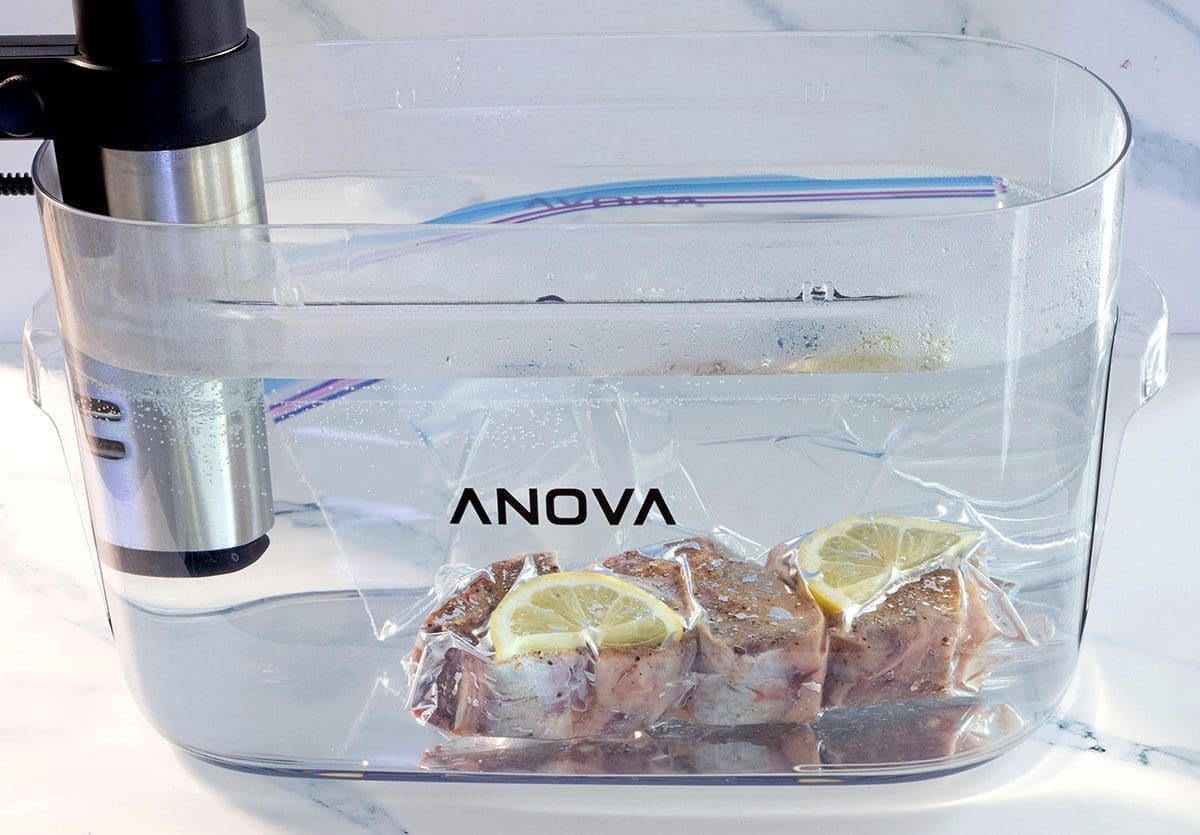Sous vide cooking has revolutionized the way home cooks achieve perfectly cooked meals. To get started, it’s essential to have the right equipment, ensuring consistent results every time.

What Is Sous Vide
Sous vide, French for “under vacuum,” is a cooking technique where food is vacuum-sealed in an airtight bag and submerged in a water bath maintained at an exact temperature using an immersion circulator. This cooking method ensures the food cooks evenly and eliminates the risk of overcooking or undercooking.
The sous vide process cooks food gently and consistently, locking in moisture and flavor while preserving nutrients, resulting in evenly cooked, flavorful dishes. It’s perfect for tough cuts of meat requiring a long cooking time, such as Sous Vide Chuck Roast, and delicate items like Sous Vide Lobster or Sous Vide Shrimp.
Pork is a notorious protein for overcooking, so making this Sous Vide Pork Chops Recipe or Sous Vide Pork Tenderloin Recipe is a great way to introduce yourself to the magic of this technique.

Essential Equipment For Sous Vide Cooking
To begin sous vide cooking, you’ll need a few pieces of equipment. These essential tools will fully equip you to enjoy all its benefits with precision and convenience.
Sous Vide Immersion Circulator
The immersion circulator is the core piece of sous vide equipment. It heats and circulates the water in a container to maintain a precise and consistent temperature throughout cooking. Modern models often come with digital controls, timers, and app integration for ease of use.
All sous vide recipes posted on FoodieandWine.com use the Anova Precision Cooker 2.0. Other popular models are the Anova Precision Cooker 3.0 and the Inkbird Circulator.

Vacuum Sealer and Bags
A vacuum sealer is crucial for removing air from bags and sealing food tightly before it’s submerged in the water bath. This airtight seal ensures even cooking, prevents water from entering the bag, and locks in flavors. Food-safe vacuum-sealed bags are the most common choice, but reusable silicone bags are a more sustainable option.

Water Container
You’ll need a large pot or a dedicated water container to hold the bath. While many people start with a simple stockpot, specialized sous vide containers with lids or insulation are available to minimize heat loss and evaporation during long cooking times.
Bag Weights, Clips or Racks
Bag clips are handy for securing food bags to the side of the container, preventing them from floating. Alternatively, sous vide racks can organize multiple bags, submerging and separating them for even cooking. These tools are invaluable when cooking multiple portions or items at once. As you can see in the below picture, these blue sous vide weights are in my arsenal.

Insulating Cover
An insulated lid can reduce water evaporation during long cooking sessions. This helps maintain water levels and temperature consistency, saving energy and reducing the need to refill water. If you don’t have a specialty sous vide container with a lid, I highly recommend just using a cookie sheet on top of your container to help keep in the heat. It’s more than likely something you already have in your kitchen.
Tongs
Tongs are essential for safely removing hot food bags from the water bath without tearing them. Look for tongs with a soft grip or silicone ends to avoid damaging the bags.
Skillet or Cast Iron Pan
While not directly part of sous vide cooking, a skillet or cast iron pan is essential for finishing meats or other items after they’re cooked sous vide. A quick sear at high heat creates a crispy, browned exterior that complements the tender texture achieved in sous vide cooking.

Thermometer
Although the immersion circulator controls the temperature, an instant-read thermometer can double-check doneness when finishing or serving food.
Reusable Silicone Bags
For environmentally conscious cooks, reusable silicone bags are a great alternative to single-use plastic vacuum bags. They are durable, heat-resistant, and easy to clean.

Sous Vide Recipes
Sous vide cooking allows home cooks to achieve restaurant-quality results with minimal effort. Investing in the essential equipment and understanding the basics allows you to elevate your culinary creations and enjoy perfectly cooked meals every time.
A few more favorites around these parts:

